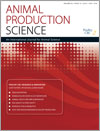
Animal Production Science
Volume 53 Number 12 2013
Poultry CRC: Research & Innovation
AN12374Natural plant extracts and prebiotic compounds as alternatives to antibiotics in broiler chicken diets in a necrotic enteritis challenge model
The continued use of antibiotics in poultry diets poses a health risk to the birds and humans, as bacteria develop resistance to such products. This study was aimed at identifying natural alternatives to antibiotics to control intestinal disorders in poultry. None of the test products was as efficient as an antibiotic but they showed some antibiotic qualities to different degrees and are worthy of further testing.
AN12374 Abstract | AN12374 Full Text | AN12374PDF (611 KB) Open Access Article
AN12272Quantitative molecular assays for evaluating changes in broiler gut microbiota linked with diet and performance
Changes in gut microbiota have been linked to altered feed efficiency in meat chicken. Molecular assays were developed to target several gut bacteria implicated in broiler performance and used to screen a series of feeding trials, where changes in lactobacilli and total bacteria were shown to be significantly linked to feed efficiency. These quantitative assays could be expanded to include other organisms of interest and used as a screening tool in evaluating dietary additives for improved broiler production.
AN12272 Abstract | AN12272 Full Text | AN12272PDF (149 KB) Open Access Article
AN12426Identification of differential duodenal gene expression levels and microbiota abundance correlated with differences in energy utilisation in chickens
Understanding the basis of variations in the efficiency with which production animals utilise food may allow the design of better production methods. We have compared gut gene expression and microbiota composition in chickens with extremes of energy use efficiency and have found differences. Further work is now required to determine if the differences can be harnessed to generally increase energy efficiency.
AN12426 Abstract | AN12426 Full Text | AN12426PDF (402 KB) | AN12426Supplementary Material (686 KB) Open Access Article
AN12342Close human presence reduces avoidance behaviour in commercial caged laying hens to an approaching human
The human–animal relationship has consequences for the welfare of laying hens by determining how stressful they find human contact. The present study manipulated the human–animal relationship in commercial caged laying hens, and determined that close proximity, but not duration, of visual human contact was effective in reducing the behavioural response of hens to human approach. Stockpeople may consider working more closely to the cages to reduce fear of humans in their flock.
AN12342 Abstract | AN12342 Full Text | AN12342PDF (184 KB) Open Access Article
AN12390Examining the usefulness of a Y-maze choice method to measure the preferences of laying hens
This study looked at a way to ‘ask’ hens about the relative importance of contact with other birds and access to a dustbath compared with access to feed using a Y maze choice test and results showed birds had a strong preference for feed over both contact with other birds and dustbathing access. These results were consistent with other similar research and indicate that this method of measuring bird preferences is a reliable and valid approach.
AN12390 Abstract | AN12390 Full Text | AN12390PDF (214 KB) Open Access Article
AN12345Egg quality and age of laying hens: implications for product safety
Egg quality was monitored in flocks of laying hens at different ages to investigate the importance of egg quality to the food safety of table eggs. Egg quality generally deteriorated with increasing flock age although the amount of cuticle present on the eggs did not vary with flock age. Changes in egg quality with flock age do not appear to be a risk factor for food safety.
AN12345 Abstract | AN12345 Full Text | AN12345PDF (424 KB) Open Access Article
AN12337The potential for probiotics to prevent reproductive tract lesions in free-range laying hens
In free-range systems, hens live in an open environment and may become prone to bacterial infections. Probiotics have been shown to prevent gastrointestinal infections. This study investigated the effects of two probiotics given in the drinking water. It was demonstrated that treatment with probiotics significantly improves reproductive tract health, reduces mortality and increases performance of free-range hens.
AN12337 Abstract | AN12337 Full Text | AN12337PDF (1.8 MB) Open Access Article
AN12343Odour, dust and non-methane volatile organic-compound emissions from tunnel-ventilated layer-chicken sheds: a case study of two farms
Odours and dust from poultry sheds can offend the surrounding community. The aim of this research was to measure the dust and odour emission rates from modern Australian poultry sheds. Odour and dust emission rates measured in this project will be useful to improve planning of new and expanding poultry farms and reduce the potential for impacts.
AN12343 Abstract | AN12343 Full Text | AN12343PDF (1.1 MB) Open Access Article



